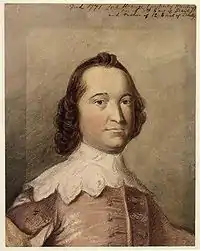James Smith-Stanley, Lord Strange
James Smith-Stanley, Lord Strange (1716–1771) was commonly known by that title, though neither he nor his father had any claim to it. He was the eldest son of Edward Stanley, 11th Earl of Derby, whose predecessor's heirs had used that courtesy title, but the right to two successive baronies Lord Strange (being baronies by writ) had descended to daughters, when the earldom had passed to the heir male.
| James Stanley's Name Act 1747 | |
|---|---|
| Act of Parliament | |
.svg.png.webp) | |
| Long title | An Act to enable James Stanley Esquire, commonly called Lord Strange, Eldest Son and Heir Apparent of Edward Earl of Derby, and his Issue by Lucy his Wife (late Lucy Smith), to take and use the Surname of Smith, and bear the Arms of Smith and Hertz. |
| Citation | 21 Geo. 2. c. 4 |
| Dates | |
| Royal assent | 25 March 1748 |

James Stanley married Lucy daughter and coheir of Hugh Smith of Weald Hall, Essex, and took the additional surname Smith on his marriage. This marriage produced Edward Smith-Stanley, 12th Earl of Derby and several other children, including Thomas Stanley (1753–1779).[1] He died before his father, so that the earldom passed straight to his son.
He attended Westminster School where he became a close friend of the future soldier, playwright, and politician John Burgoyne, who was to surrender his army at Saratoga in 1777. As a young man, Burgoyne eloped with Lord Strange's sister. Burgoyne also wrote a masque to celebrate the wedding of Edward Smith-Stanley to Lady Elizabeth Hamilton, a daughter of James Hamilton, 6th Duke of Hamilton.
Public service
Lord Strange was a Member of Parliament for Lancashire from 1741 until his death. He was Chancellor of the Duchy of Lancaster in the ministry of Lord North from 1762 and became a Privy Councillor at the same time.
As Lord Lieutenant of Lancashire during the Seven Years' War, he was tasked with calling out the Lancashire Militia, which had been disembodied since 1746. Although Lancashire's quota was only a single regiment, and despite Strange's enthusiasm, it was not until July 1760 that the regiment attained 60 per cent of its establishment and was issued with arms. Strange was then commissioned as its Colonel (15 July 1760). The regiment was finally embodied for full-tine service on 23 December that year. In October 1761 King George III presented the Regimental Colours and granted it the title 'Royal Lancashire Militia', the colonel's own company becoming 'the King's Company'. The regiment was disembodied in December 1762 as the war was coming to an end, but Strange remained its colonel for the rest of his life.[2][3]
He is mentioned by Parkman as plenipotentiary to Paris and Choiseul, and advisor to Pitt, during the 1760s turbulence that attended the Treaty of Paris (1763).[4]
Ancestry
| Ancestors of James Smith-Stanley, Lord Strange | ||||||||||||||||||||||||||||||||||||||||||||||||||||||||||||||||||||||||||||||||||||||||||||||||||||||||||||||||||||||||||||||||||||||||||||||||||||||||||||||||||||||||||||||||||||||||||||||||||||||||||||||||||||||||||||||||||||||||||||||||||||||||||||||||||||||||||||||||||||||||||||||||||||||||||||||||||||||||||||||||||||||||||||||||||||||||||||||||||||||||||||||||||||||||||||||||||||||||||||||||||||||||||||||||||||||||||||||||||||||||||||||||||||||||||||||||||||||||||||||||||||||||||||||||||||||||||||||||||||||||||||||||||||||||||||||||||||||||||||||||||||||||||||||||||||||||||||||||
|---|---|---|---|---|---|---|---|---|---|---|---|---|---|---|---|---|---|---|---|---|---|---|---|---|---|---|---|---|---|---|---|---|---|---|---|---|---|---|---|---|---|---|---|---|---|---|---|---|---|---|---|---|---|---|---|---|---|---|---|---|---|---|---|---|---|---|---|---|---|---|---|---|---|---|---|---|---|---|---|---|---|---|---|---|---|---|---|---|---|---|---|---|---|---|---|---|---|---|---|---|---|---|---|---|---|---|---|---|---|---|---|---|---|---|---|---|---|---|---|---|---|---|---|---|---|---|---|---|---|---|---|---|---|---|---|---|---|---|---|---|---|---|---|---|---|---|---|---|---|---|---|---|---|---|---|---|---|---|---|---|---|---|---|---|---|---|---|---|---|---|---|---|---|---|---|---|---|---|---|---|---|---|---|---|---|---|---|---|---|---|---|---|---|---|---|---|---|---|---|---|---|---|---|---|---|---|---|---|---|---|---|---|---|---|---|---|---|---|---|---|---|---|---|---|---|---|---|---|---|---|---|---|---|---|---|---|---|---|---|---|---|---|---|---|---|---|---|---|---|---|---|---|---|---|---|---|---|---|---|---|---|---|---|---|---|---|---|---|---|---|---|---|---|---|---|---|---|---|---|---|---|---|---|---|---|---|---|---|---|---|---|---|---|---|---|---|---|---|---|---|---|---|---|---|---|---|---|---|---|---|---|---|---|---|---|---|---|---|---|---|---|---|---|---|---|---|---|---|---|---|---|---|---|---|---|---|---|---|---|---|---|---|---|---|---|---|---|---|---|---|---|---|---|---|---|---|---|---|---|---|---|---|---|---|---|---|---|---|---|---|---|---|---|---|---|---|---|---|---|---|---|---|---|---|---|---|---|---|---|---|---|---|---|---|---|---|---|---|---|---|---|---|---|---|---|---|---|---|---|---|---|---|---|---|---|---|---|---|---|---|---|---|---|---|---|---|---|---|---|---|---|---|---|---|---|---|---|---|---|---|---|---|---|---|---|---|---|---|---|---|---|---|---|---|---|---|---|---|---|---|---|---|---|---|---|---|---|---|---|---|---|---|---|---|---|---|---|---|---|---|---|---|---|---|---|---|---|---|---|---|---|---|---|---|---|---|---|---|---|---|---|---|---|---|---|---|---|---|---|---|---|---|---|---|---|---|---|---|---|---|---|---|---|---|---|---|---|---|---|---|---|---|---|---|---|---|---|---|---|---|---|---|---|---|---|---|---|---|---|---|---|---|---|---|---|---|---|---|---|---|---|---|---|---|---|---|---|---|---|---|---|---|---|---|---|---|---|---|---|---|---|---|---|---|---|---|---|---|---|---|---|---|
| ||||||||||||||||||||||||||||||||||||||||||||||||||||||||||||||||||||||||||||||||||||||||||||||||||||||||||||||||||||||||||||||||||||||||||||||||||||||||||||||||||||||||||||||||||||||||||||||||||||||||||||||||||||||||||||||||||||||||||||||||||||||||||||||||||||||||||||||||||||||||||||||||||||||||||||||||||||||||||||||||||||||||||||||||||||||||||||||||||||||||||||||||||||||||||||||||||||||||||||||||||||||||||||||||||||||||||||||||||||||||||||||||||||||||||||||||||||||||||||||||||||||||||||||||||||||||||||||||||||||||||||||||||||||||||||||||||||||||||||||||||||||||||||||||||||||||||||||||
References
- Burke's Peerage (1939 edition), s.v. Derby, Earl of
- Maj R.J.T. Williamson & Col J. Lawson Whalley, History of the Old County Regiment of Lancashire Militia, London: Simpkin, Marshall, 1888, pp. 87–115.
- J.R. Western, The English Militia in the Eighteenth Century, London: Routledge & Kegan Paul, 1965, p. 125; Appendices A & B.
- Parkman, Francis: "Montcalm and Wolfe"
- "The Pedigree of Elizabeth Hesketh". "Fabulous" Pedigree. Jamie Allen's Family Tree. Retrieved 3 September 2022.
.jpg.webp)